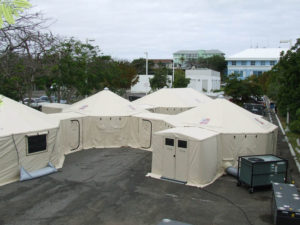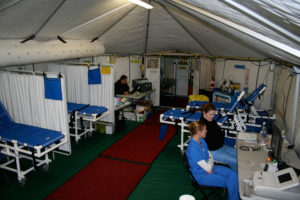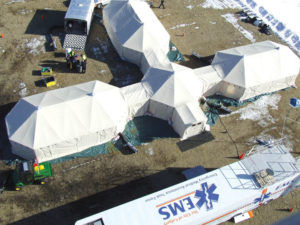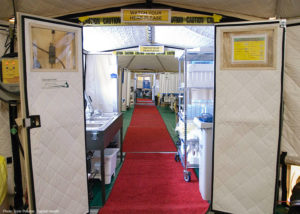Design Shelter and Medizone partner to combat hospital-acquired infectious diseases.
A company that develops disinfection technology for hospitals has teamed with a Canadian shelter manufacturer to devise a prototype mobile hospital system to combat hospital-acquired viral infections, including Ebola and the MERS-CoV.
Medizone International Inc., Sausalito, Calif., developed AsepticSure®, a system that combines ozone and peroxide to kill viruses in a sealed space, including all surfaces and equipment in the space.

“When ozone and peroxide are mixed together they produce a new compound called trioxidane, and it’s absolutely lethal,” says Dr. Michael E. Shannon, Medizone’s president and director of medical affairs. Shannon is a former deputy surgeon general of Canada and previously served as director general for Canada’s Laboratory Centre for Disease Control.
“Within 90 minutes you’ve got a space that’s basically sterilized,” he says. “Doesn’t matter what’s in [the room], it does curtains — it does everything.”
The company partnering with Medizone, Design Shelter Inc. of Mississauga, Ont., Canada, specializes in soft-walled portable shelters with market applications for remote workforces, disaster relief, ecotourism and more. The company first adapted its shelters for a field hospital system following the 2003 SARS outbreak in Canada. The advantage of a portable hospital in a virus epidemic is that it can be taken to the outbreak location and avoid having patients congregating at centralized hospitals, exceeding hospital capacity and contaminating the general hospital population.

“We needed to find a suitable solution for disinfection, so that’s what brought us to Medizone and their technology for disinfection of the actual shelter system,” says Brad Matchung, Design Shelter president “This allows for the effective reuse of the kit because once you have treated one patient you can then disinfect the facility to treat the next patient, or disinfect the entire kit post-event and pack it away to be used another time.”
The Design Shelter system offers several features that make it an ideal tent for the AsepticSure technology. The ability to seal a space during the disinfection process is key because a leak results in two problems: ozone being released into other areas, and a failure to get the concentration levels required for complete kill of a virus, Shannon says.

“We redesigned the way the fabric is attached to the main frame and we redesigned our flooring system to minimize areas for air infiltration or air escape,” Matchung says. “Although the Medizone technology creates a pressure neutral environment inside the shelter, one still needs to minimize the amount of ozone that escapes the structure. We did a number of minor modifications that allowed us to make the shelter adequately air tight for the Medizone technology to work appropriately.”
Another key attribute is the ability to reuse the system. Often in the case of infectious pandemics, all equipment is incinerated after the event.
“Since ozone is an extremely potent oxidizing gas, many fabrics and materials that are typically used in portable shelter or tent construction would be subject to damage by the ozone,” Matchung says. “So we conducted extensive testing of our shelter materials, which makes us quite unique in that we know beyond a shadow of a doubt that the Medizone disinfection process will not adversely affect our materials.”

A specialized thermal insulation layer allows the structures to be used in both extreme cold and extreme heat with lowered fuel costs. The modular system can be easily reconfigured depending on the type of health emergency. Individual shelters range from 300 to 800 square feet and can be set up by four people in less than 20 minutes.
“It’s a product that is not only flexible and designed for unique applications, but it also provides energy efficiency in the field,” Matchung says.
 TEXTILES.ORG
TEXTILES.ORG


